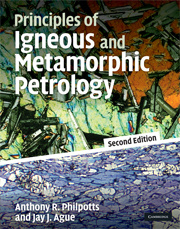Book contents
- Frontmatter
- Contents
- Preface
- Acknowledgments
- List of units
- 1 Introduction
- 2 Physical properties of magma
- 3 Intrusion of magma
- 4 Forms of igneous bodies
- 5 Cooling of igneous bodies and other diffusion processes
- 6 Classification of igneous rocks
- 7 Introduction to thermodynamics
- 8 Free energy and phase equilibria
- 9 Thermodynamics of solutions
- 10 Phase equilibria in igneous systems
- 11 Effects of volatiles on melt equilibria
- 12 Crystal growth
- 13 Isotope geochemistry related to petrology
- 14 Magmatic processes
- 15 Igneous rock associations
- 16 Metamorphism and metamorphic facies
- 17 Deformation and textures of metamorphic rocks
- 18 Graphical analysis of metamorphic mineral assemblages
- 19 Geothermometry, geobarometry, and mineral reactions among solid solutions
- 20 Mineral reactions involving H2O and CO2
- 21 Material transport during metamorphism
- 22 Pressure–temperature–time paths and heat transfer during metamorphism
- 23 Origin of rocks
- Answers to selected numerical problems
- References
- Index
10 - Phase equilibria in igneous systems
- Frontmatter
- Contents
- Preface
- Acknowledgments
- List of units
- 1 Introduction
- 2 Physical properties of magma
- 3 Intrusion of magma
- 4 Forms of igneous bodies
- 5 Cooling of igneous bodies and other diffusion processes
- 6 Classification of igneous rocks
- 7 Introduction to thermodynamics
- 8 Free energy and phase equilibria
- 9 Thermodynamics of solutions
- 10 Phase equilibria in igneous systems
- 11 Effects of volatiles on melt equilibria
- 12 Crystal growth
- 13 Isotope geochemistry related to petrology
- 14 Magmatic processes
- 15 Igneous rock associations
- 16 Metamorphism and metamorphic facies
- 17 Deformation and textures of metamorphic rocks
- 18 Graphical analysis of metamorphic mineral assemblages
- 19 Geothermometry, geobarometry, and mineral reactions among solid solutions
- 20 Mineral reactions involving H2O and CO2
- 21 Material transport during metamorphism
- 22 Pressure–temperature–time paths and heat transfer during metamorphism
- 23 Origin of rocks
- Answers to selected numerical problems
- References
- Index
Summary
INTRODUCTION
When first encountered, the great variety of igneous rocks and the large number of names and textural terms used to describe them can be bewildering. Diagrams showing the relations between mineralogical parameters, such as the composition of feldspar, abundance of ferromagnesian minerals, and so on, or the variation between major chemical constituents, provide a means of attaching names to rocks, but they do not, in themselves, provide an explanation for the compositions and frequency of occurrence of rock types. These diagrams can be likened to the periodic table of the elements; they provide a means of classifying, but the underlying important factors justifying such a classification have to be sought elsewhere. Thermodynamics provides the rationale for rock compositions.
Ideally, when a magma crystallizes at a given pressure and temperature, an assemblage of minerals is formed that provides the minimum free energy possible for that particular bulk composition under the existing conditions. A close approach to this ideal situation is common in igneous rocks, particularly plutonic ones, and even when equilibrium is not achieved, mineral assemblages can still be understood in terms of reactions that are striving to bring about this minimization of free energy. Thermodynamics, therefore, provides a simple explanation for the mineralogical composition of igneous rocks, and as will be seen later, it can also be used to account for the composition of magmas.
- Type
- Chapter
- Information
- Principles of Igneous and Metamorphic Petrology , pp. 194 - 242Publisher: Cambridge University PressPrint publication year: 2009



